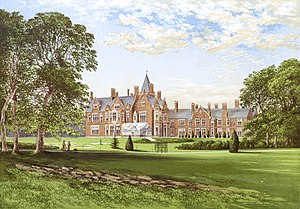Bagshot Park

Bagshot Park is a royal residence located near Bagshot, a village 11 miles (18 km) south of Windsor and approximately 11 miles (18 km) north west of Guildford (Grid reference: SU 9164). It is the current home of The Earl and Countess of Wessex. Bagshot Park is on Bagshot Heath, a fifty square-mile tract of formerly open land in Surrey and Berkshire. It is only a few miles from Sunninghill Park, the former residence of the Duke and Duchess of York.
Prince Edward renovated Bagshot Park as a residence for himself and as a base for his film production company, Ardent Productions, until he closed the business. The estate is farmed.
History
The original Bagshot Lodge (not the present Lodge, visible on the public road at the entrance to the drive) was built between 1631 and 1633[1] as one of a series of small lodges designed for King Charles I by Inigo Jones. It was remodelled between 1766 and 1772 according to designs of James Paine for George Keppel, the 3rd Earl of Albemarle,[2] and altered in 1798 by Sir John Soane[3] for the Duke of Clarence (later King William IV), who lived there until 1816.
Bagshot Park was subsequently used by Prince William Frederick, Duke of Gloucester, nephew of King George III. The Duke added pieces of property between the estate and Sunningdale; his widow, Princess Mary, daughter of King George III, continued to live there after his death until she moved out in 1847.[4] The original house was demolished in 1877-78[5]
A new building with 120 rooms was completed in 1879. The 1881 census records an equerry and 26 servants living in the main house: an under butler, a housekeeper, four valets, two lady's maids, two dressers, a cook, three kitchen maids, three housemaids, three footmen, a page, a porter, a scullery maid, two other junior posts and a soldier. A coachman and seven grooms lived in the stables. Two other domestic staff lived in one of the lodges, three agricultural workers lived in another, and one gardener is recorded as living on the estate.[6] From 1880 this was the principal residence of Prince Arthur, Duke of Connaught and Strathearn, a son of Queen Victoria. The Duke, who was Governor General of Canada from 1911 until 1916, died at Bagshot Park in 1942.
The house was thereafter the regimental headquarters and depot of the Royal Army Chaplains' Department, who famously placed a notice by the pond reading "Please do not walk on the water". They vacated the building shortly before the Earl and Countess of Wessex took over the tenancy from the Crown. The original sign was removed when the chaplains left, but a new one, made by J.M.J. Holland Chairmakers and given to the Earl of Wessex, has replaced it.
Although the house was criticised by the architectural historian Professor Sir Nikolaus Pevsner for being ugly,[7] Bagshot Park was the most adventurous Royal house to be created since the death of Albert, the Prince Consort of Queen Victoria, in 1861, and is a remarkable monument in the history of Indian taste in Britain: an Indian billiard room wing, which inspired the more famous Durbar Room at Osborne House, was prefabricated in India and installed in the 1880s, the result of the Duke of Connaught's Indian tour, when the Duke met John Lockwood Kipling and asked him to design and oversee the installation of a billiard room in Indian taste. The Indian craftsmen who assembled and installed the room at Bagshot were housed in a tent in the grounds.[8]
Notes
- ^ History of the King's works IV.
- ^ Colvin, 1995, "James Paine".
- ^ Dorothy Stroud, 1984, Sir John Soane, Architect.
- ^ Flora Fraser, Princesses: The Six Daughters of George III 57
- ^ Colvin, 1995, "James Paine", "Sir John Soane".
- ^ Bagshot Park.
- ^ N. Pevsner, Surrey in series Buildings of England
- ^ Judith Flanders, A Circle of Sisters: Alice Kipling, Georgiana Burne-Jones, Agnes Poynter and Louisa Baldwin (New York: W.W. Norton, 2001).
References
- Colvin, Howard. (1995). A Biographical Dictionary of British Architects 1600-1840. 3rd ed. Yale University Press.

